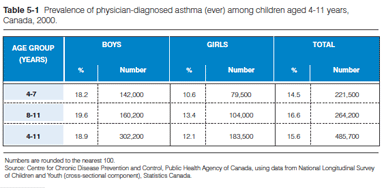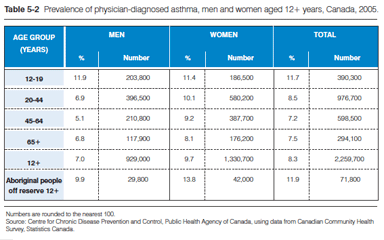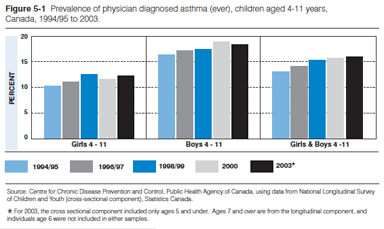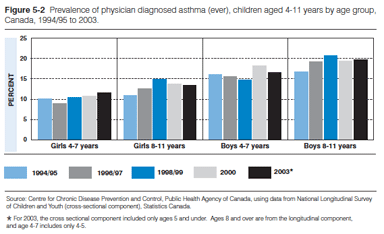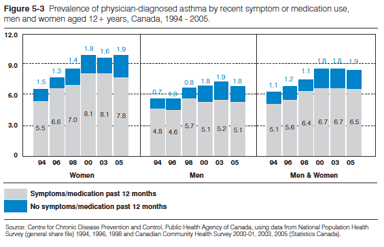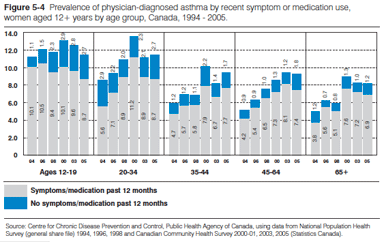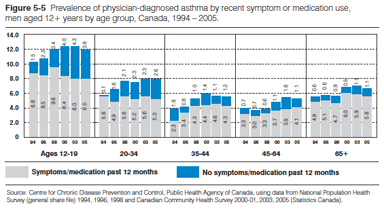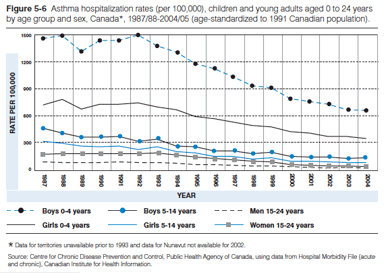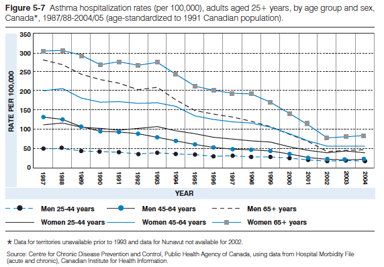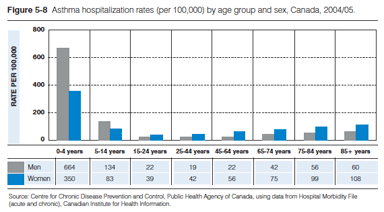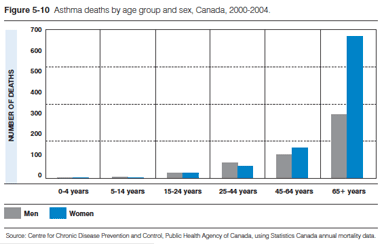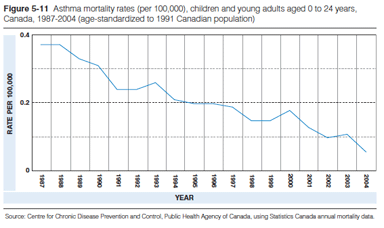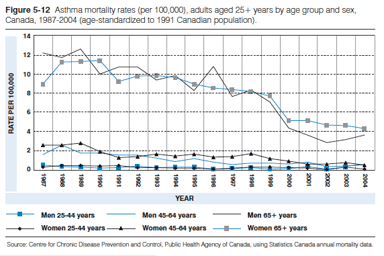Asthma
Introduction
Asthma is a chronic health disorder affecting a substantial proportion of children and adults worldwide. It is characterized by cough, shortness of breath, chest tightness and wheeze. Asthma symptoms and attacks (episodes of more severe shortness of breath) usually occur after exercise or exposure to allergens, viral respiratory infections ("colds"), irritant fumes or gases. These exposures cause an inflammation of the airway wall and an abnormal narrowing of the airways, which lead to asthma symptoms. Effective treatment can prevent the onset of symptoms in response to these triggers and can control symptoms once they occur.
Risk Factors
Longitudinal studies suggest that susceptibility to childhood asthma is determined during fetal development and in the first three to five years of life. A number of possible risk factors have been suggested for the development of asthma. They include the following:
- family history of allergy and allergic disorders (including hay fever, asthma and eczema)1
- high exposure of susceptible children to airborne allergens (pets, house dust mites, cockroaches, mould) in the first years of life2
- exposure to tobacco smoke, including in utero exposure3
- frequent respiratory infections early in life4
- low birthweight and respiratory distress syndrome (RDS)5
The onset of asthma in adults may result from occupational exposures to low molecular weight sensitizers such as isocyanates, or following exposure to infectious agents, allergens or pollution.6 It is unlikely that atmospheric pollution is a primary cause of asthma unless other factors are present. Indeed, most evidence suggests that air pollution is a trigger for worsening asthma. Among women, other possible risk factors include smoking, obesity and hormonal influences.7
Prevalence
Among Canadian children between the ages of 4 and 11 years, 15.6% (485,700 children) have ever been diagnosed with asthma (Table 5-1). The prevalence of physician-diagnosed asthma among Canadians 12 years of age and over is 8.3% overall (2.2 million Canadians). Of off-reserve Aboriginal people 12 years of age and over, 11.9% have asthma (Table 5-2). Since 1994-95, the prevalence of physician-diagnosed asthma has been consistently higher among young boys than girls, but the reverse is true among adult women and men (Figure 5-1, 5-2, 5-3). The true prevalence of asthma may differ from estimates provided in population surveys, which rely on self-reporting of physician-diagnosed asthma: some individuals with asthma may not yet have been diagnosed and others may be misdiagnosed.
An asthma attack can be a frightening event, with feelings of suffocation, breathlessness, and loss of control; it can also be life-threatening. In 2005, 70.8% of individuals with asthma 12 years of age and over reported that they had had asthma symptoms or an attack or used medications for asthma in the previous 12 months (Figure 5-3).
Between 1994-95 and 2005, the prevalence of physician-diagnosed asthma increased by 60% among women in the 35-44 year age group and 80% among women aged from 45-64 years (Figure 5-4). Prevalence also increased by 41% among men in the 35-44 year age group (Figure 5-5).
Services/Hospitalizations
Most asthma can be well controlled with medication and environmental controls allowing the individual to lead a full active life. Poor asthma control often results in time away from school, work, sports or other activities that affect quality of life. One measure of poor asthma control is visits to emergency rooms and/or hospitalizations for an asthma problem.
Hospitalizations
Hospitalization rates for asthma among children and young adults have decreased since 1987 (Figure 5-6). Hospitalization rates have also decreased among older adults since 1987, especially among those over 65 years of age (Figure 5-7). While this decline likely reflects improved disease control, another factor influencing is the downsizing in the hospital sector, which has reduced the availability of beds.
Asthma continues to be a major cause of hospitalization for children in Canada. When listed as one of the first five diagnoses on the hospitalization record, asthma contributed to 10% of all admissions in the 0-4 year age group and 8% of all admissions in the 5-14 year age group in 2004 (see Figure 1-3).
Children younger than 5 years of age had the highest hospitalization rates for asthma in 2004. Rates among boys were higher than for girls in the under-15 age group, but this reversed in older age groups (Figure 5-8). Hospitalization rates among middle-aged women were more than twice those of middle-aged men.
Emergency Visits
Emergency room (ER) visits for asthma vary during the course of the year, peaking during the third week in September for all age groups. While respiratory tract infections often precipitate asthma symptoms, visits for respiratory tract infections tend to peak in mid-winter. The cause for this phenomenon is unknown at this time (Figure 5-9).
Health Outcomes
Deaths
Although deaths from asthma are uncommon among children and young adults, even one death is unacceptable for a disease that is fully treatable. The higher number of deaths among women over age 65 reflects the higher asthma mortality rate among women and the higher number of women compared to men in this age group (Figure 5-10). Asthma mortality rates have been decreasing in all age groups since 1987, particularly in the 65+ age group (Figure 5-11 and Figure 5-12).
Discussion and Implications
While asthma is often considered a children's disease, it is common among Canadians of all age groups. Children and teens do have the highest prevalence of asthma and the highest hospitalization rates. In terms of number of people affected, however, the disease actually affects more adults than children. The prevalence among adults is increasing and is cause for concern. Further research is needed to identify the factors responsible for increased prevalence, as well as to study the primary prevention of asthma in individuals at risk.
Sex of the individual appears to be a factor in the prevalence of physician-diagnosed asthma. The condition is more common among young boys than girls and among adult women than men. This could be because women visit their physicians more often and are therefore more likely to be diagnosed. However, the difference may be due to the effect of the smaller airways of boys compared to girls and in women compared to men, hormonal influences and variable sensitivity to irritants and allergens.
The data on emergency room visits and hospitalization suggest that asthma control is improving in the population. One critical factor in control is the appropriate use of Asthma Practice Guidelines by physicians. Another critical element for effective control is the active involvement of individuals with asthma and their families. Many asthmatics need help in utilizing management strategies such as asthma action plans. Adequate training of asthma educators, funding for asthma education and increased access to this service could improve the effective control of symptoms and the appropriate use of health services by individuals with asthma. Efforts need to continue in order to further improve asthma control in the population.
Reducing exposure to airborne contaminants at school and in the workplace, as well as to second-hand smoke, house dust mites, animal dander and moulds, may help reduce the risk of asthma for sensitive individuals. It may also decrease symptoms and attacks among those with asthma.
While individuals can take personal responsibility for some preventive measures, other solutions require the collaborative efforts of government, industry and business. Legislation, policies and voluntary co-operation need to be part of a concerted effort to decrease school and workplace contaminants and improve air quality.
The current asthma surveillance system in Canada provides ongoing data on prevalence, hospitalization and death. The addition of in-depth population surveys on asthma, combined with improved use of provincial/territorial health administrative databases for surveillance, would provide additional meaningful information to policy makers.
1 Global Strategy for Asthma Management and Prevention, Global Initiative for Asthma (GINA) 2006. Available from: http://www.ginasthma.org.
5 Shaubel D et al. Neonatal characteristics as risk factors for preschool asthma. J Asthma 1996; 33:4:255-64.
6 Pearce N et al. Is allergen exposure the primary cause of asthma? Thorax 2000;424-431.
7 Chen Y et al. Increased effects of smoking and obesity among female Canadians: The National Population Health Survey, 1994/95. Am J Epidemiol 1999;150:3:255-63.

